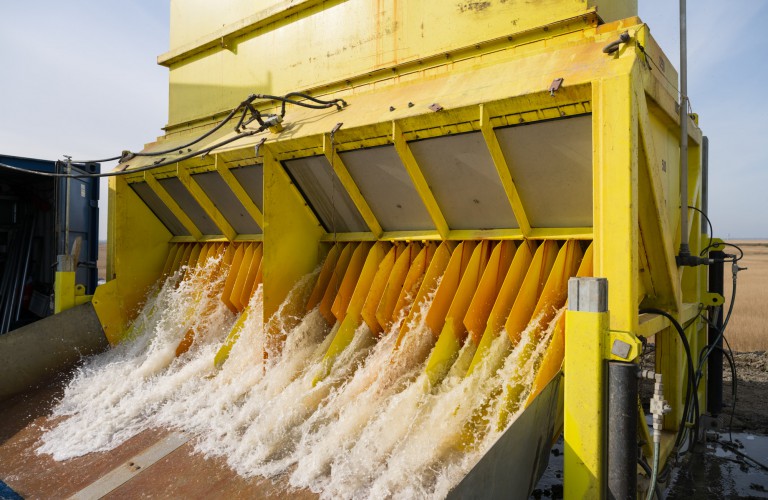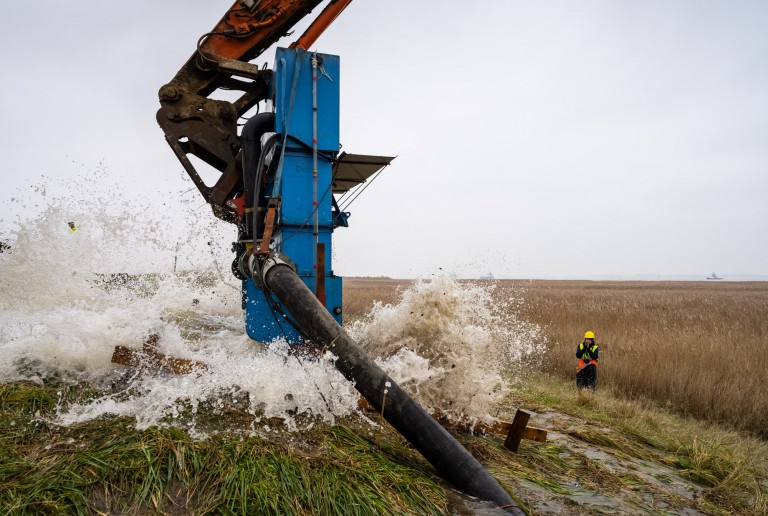Simulating superstorms to test erosion resistance
- 31 May 2022
- Francien Horrevorts
- Flood Defence
Erosion resistance of the levee slopes is a key research topic for Polder2C’s partners concerned with Flood Defence. Research on the impact of water overflowing, waves overtopping the levee and waves hitting the levee was included in the project, even simulating the effect of a superstorm.
Series of erosion tests
Over the course of two years, several experiments have been done in the Living Lab Hedwige-Prosperpolder to find out more about erosion resistance. How strong is the vegetation cover of the levee, how much water flow can it withstand and what is the effect of vegetation, animal burrowing or other anomalies on the levee slope on the resistance against erosion? These are some examples of questions the researchers tried to answer. For this purpose, in 2020 and 2021 three series of overflow tests have been done. In 2022 additional data were gathered during wave overtopping and wave impact tests.


Impressive machinery
Early this year, two impressive machines were taken to the levee in the Hedwige-Prosperpolder, a wave overtopping simulator and a wave impact generator. The wave overtopping simulator creates waves that are overtopping the crest of the levee during a super storm. The wave impact generator simulated waves hitting the river side slope of the levee. This machine is filled with water and when released, the water hits the levee. The longer you wait before releasing, the more water is in the tank and the bigger the wave.
"As the levee did not have an active flood defence function anymore, more extreme forces were allowed, even the simulation of a superstorm."
Both machines put the levee through some extreme conditions as the size, number and force of the waves could be manipulated. As the levee in the Living Lab Hedwige-Polder did not have an active flood defence function anymore, the tests could proceed until damage occurred. Therefore, more extreme forces were allowed, even the simulation of a superstorm.
Wave overtopping
Several wave overtopping tests were done. The intensity and volume of the waves differed; small waves of around 0.5 meter in height run over the crest of the levee for a short period of time and for a longer period of time, say 16 to 20 hours. In another test, the height of the waves was increased to 2 meters. The condition of the levee differed as well; tests were done on a levee strip with a wet spot and some animal burrows. Also, on two strips of the levee, the vegetation cover had been removed in order to test the erosion of the clay layer itself.
See the video below to get an impression of a wave overtopping test.
Wave impact
On the levee strip that was used for the wave impact test, several months prior to the test grass sods were placed on the levee after removing the original grass cover. If the grass sods are strong enough to hold against these waves, it can serve as a repair measure for patching up bald spots on a levee. More to come on the final results!
Check the video below and see the waves hitting the levee during the wave impact test.
Results
So far, all tests concerning erosion resistance show that the levees are quite strong and can withstand an impressive amount and force of water, as long as the grass cover is intact. However, as soon as any anomalies occur, such as animal burrows or holes, a damaged cover, sudden damage can occur to the levee slope in a very short time. This shows that both inspection, maintenance and management of the levees are of utmost importance to keep the hinterland safe.
Photo credits: Mischa Keijser
